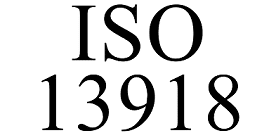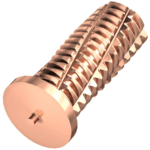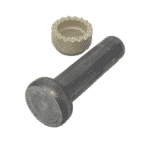What is Stud Welding?
In its simplest form, it is the process of fastening a stud weld (also called a fastener or simply a “stud”) to a base metal. The key factors that differentiates stud welding from other forms of welding are its one-step process (which makes application nearly instantaneous) and the lack of reverse-side marking. The use of “stud guns” to apply the fastener to the base metal makes this process extremely simple and efficient.
Arc Welding and CD Welding
There are two primary forms of stud welding: “Arc” and “Capacitive Discharge” (CD for short). These two processes differ in the application of the weld fastener, as well as what materials are most suitable.
Capacitive Discharge Welding
CD welding is best-suited for smaller diameter fasteners and thinner base metals. Most CD studs and fasteners have a special tip, which aids both in alignment and in the power-discharge process. The size of the stud tip also affects the amount of reverse-side marking visible once the weld is complete.
First, the stud and stud gun will be placed onto the desired weld site. When the stud gun is activated, energy is released from the stud gun into the fastener, melting the tip of the stud and a small portion of the base metal. Then, the stud is forced into the molten material through spring-loaded action, creating a strong fusion weld. The finished product is a full bond between the parent metal and the stud itself.
Arc Welding
In contrast to capacitive discharge welding, arc welding is best-suited for large diameter studs and thicker, rougher base metals. Arc welding is also distinct in its use of ceramic ferrules, which sit around the weld site and are used to keep the weld secure during the fusion process.
Like CD welding, arc welding first begins by placing the stud gun and stud on the base metal. Energy is then discharged into the stud, melting both the tip of the fastener and the parent metal. The ceramic ferrule works to retain heat and the molten material in the weld site for maximum weld strength.
Once both the stud and the parent metal are molten, the stud is plunged into the base plate; after cooling and solidification, the result is a strong fusion bond between the fastener and the parent metal.
For an in-depth guide on arc and CD welding, visit our info page here.
Why Stud Welding?
What benefits do CD or Arc welding have over other forms of fastening, like drilling or tapping holes? First, these forms of welding are versatile, allowing the operator to weld different kinds of metals together quickly and easily. Arc and CD welding also occur in a single step–simply place the stud and stud gun onto the weld site, activate the gun, and the result is a near-instantaneous permanent weld with minimal reverse side marking. Finally, stud welding systems also allow operators to finely tune their desired energy output, which keeps every weld consistent.
If the benefits of using a stud welding system interest you, you can view our large inventory of capacitive discharge stud welders and arc stud welding units!





